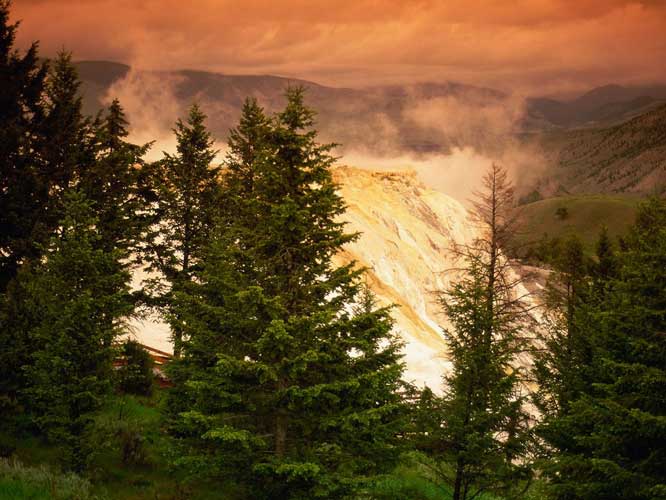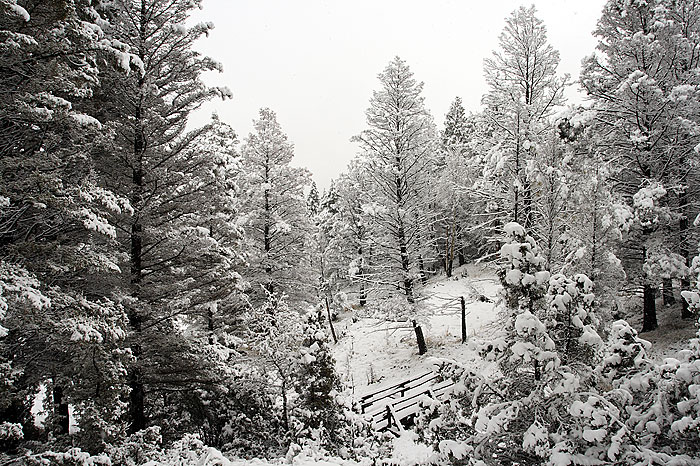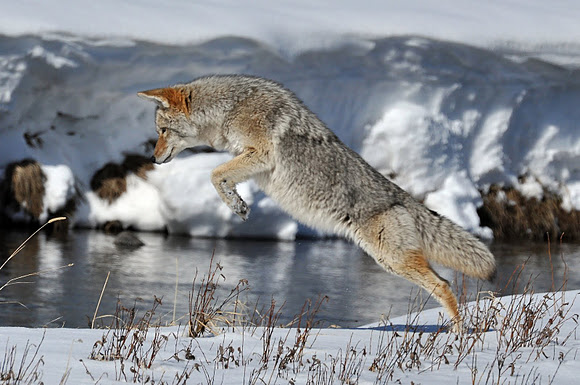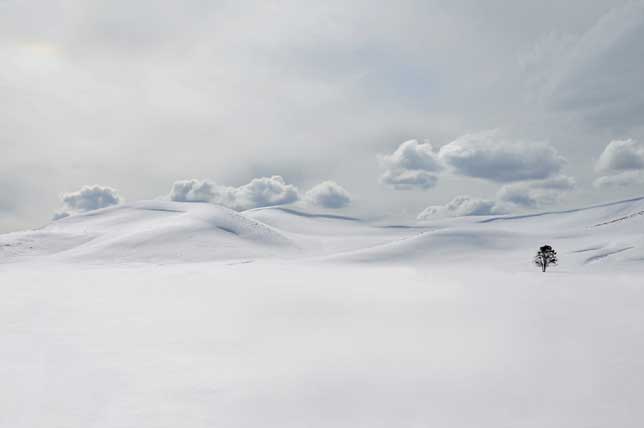Mammoth Terraces, Yellowstone National Park, Wyoming: ‘In Yellowstone, winter is always possible.’Looking For Winter
The story in the silence and stillness of Yellowstone National Park
By Christine Baleshta
When I drive through the arches on a cold February morning, I enter a mostly silent world of dark green with patches of white and shades of mineral red and orange. There is little snow on the Rescue Creek Trail and along the Gardiner River. The sky is blue now, but the clouds roll in shortly as the road winds and climbs to Mammoth Hot Springs. Elk, bison, and deer stare down from the hills and leap across the road carefully and quickly. They take note of each newcomer. The Mammoth Terraces are steam and frost, a subdued blend of orange, green, brown and red on an icy background. Rabbit and coyote tracks follow each other and climb the snowy slopes alongside the boardwalk. It is 28 degrees. Already I am totally distracted by the pristine beauty of this place in winter.
Where I live we wait for winter. It arrives late, sometimes not until after Christmas, and teases us with frost on the grass and morning temperatures in the low thirties. In fortunate years snow decorates the pecans and live oaks for a day and disappears in the warm sun. Then winter leaves almost as suddenly as it arrives. In Yellowstone winter is always possible. It can--and does--snow almost any time of year. I have been here once before in winter, catching the very last day and the very first day of spring. I want to see how this place is in the center of the season covered by snow and silence, when it seems that everything sleeps.
‘In Yellowstone, winter is always possible’: This photograph, titled ‘Winter Wonderland in Yellowstone National Park,’ is a color image taken by photographer Gale Rainwater on Oct. 1, 2007. (Photo: Gale Rainwater Photography)Only one road is open to vehicles in winter. The road from the north entrance climbs to Mammoth Hot Springs and then turns east, winding and dipping on ice past Wraith Falls, through the Blacktail Deer Plateau and Little America. It crosses the Lamar River, a rocky and frozen ribbon of water, and enters the Lamar Valley where elk spend the winter and the first wolves found a paradise. As the road passes Round Prairie and Pebble Creek, snow becomes heavier and evergreens become thicker, taller and closer to the road. It travels alongside Soda Butte Creek out of the Park and dead ends in Cooke City. This is my path to Buffalo Ranch.
My little jeep is the only vehicle on the road. Near Phantom Lake a single bull elk makes his way down a hill. Slowly, precisely he steps, one hoof at a time. It seems that at this moment he is the only animal in the park. And I feel like I am the only human in the park. Later in the week, not far from here, I will watch three men standing around a bull elk, lying in a stream not far off the road. The elk is old, too weak to get up, and his teeth are worn down. It is one of the harsh and painful realities of life in the park I am confronted with. When I saw the elk I looked, and then looked away, searching for understanding.
In Little America I pull over to watch a coyote bedded down in the snow maybe 30 feet from the road. He just lay there, his head on his paws, getting up every now and then when a car passed. A man from California spotted him and was taking pictures of him. For the most part, the coyote was a willing subject, changing position to have a better look at us. At one point we approach too closely and he starts to run off. I back up and return to my car where I enjoy his company while eating lunch. He is still there when I pull out.
A coyote in winter in Yellowstone National Park (Photo: Lin Dzurisin, Project Noah)Later that evening in the Lamar Valley I watch a pair of coyotes hunting for at least 30 minutes. They have interesting markings on their backs as if a black line was drawn diagonally from almost the middle of their backs to their front legs. There are two black spots on their tails, one at the base of the tail and one at the tip. A pack of seven coyotes lives in the valley, an energetic and vocal bunch. Later in the week I will watch a pair chasing each other, on and off the road. One play bows; the other tail up and wagging, rubs the other’s nose. Courting or play? The first dashes off, looking back, and the romp through the snow is on.
Two bighorn sheep jump across the road from the creek near the confluence. Their tan color blends in so well with the rocky ledges along the road I almost don’t see them. They graze between the rocks near the road, one eye on the jeep driving by. A little farther down two bison amble down the middle of the road. The bison seem to use the road a little more in winter, zigzagging back and forth, sometimes walking, sometimes trotting, refusing to stay on one side or the other. Darkness falls quickly like a huge curtain drawn on the valley. A sliver of moon accompanied by Venus pierces the blackness of the windless night. The jeep crawls slowly behind the bison giving them plenty of room.
Last month Tauck World Discovery offered an eight-day ‘Winter Wonderland Experience’ trip to Yellowstone’s winter world. The trip was crafted by Tauck and filmmakers Ken Burns and Dayton Duncan (who collaborated on The National Parks: America’s Best Idea). This is the promotional video for the event, featuring commentary by both Duncan and Burns concerning the special encounter winter in Yellowstone can be.Each morning I wake to a black and white world. The sun begins to rise around 6:45 a.m. bringing light and warmth and color. On Jasper bench, seven of the Druid Peak pack are piled together in the snow. They are rocks until they lift their heads when ears and noses and tails appear. In the spotting scope they become true black and grey wolves.
On the opposite ridge, one of the female wolves who left the Druid pack is bedded down with two males from the Slough Creek pack. They, too, are barely visible. A single black wolf moves down the hillside away from the trio. Someone says it’s a Druid pup, separated from the pack. It seems like he wants to cross the road, but is afraid. I turn away briefly to gaze at an almost vertical rainbow stretching from the snow to the clear blue sky. I hear a howl and wonder if it’s the pup.
This day the temperature does not rise above 17 degrees. I trudge through knee deep snow to the creek, warmed and blinded by the noon sun. Specimen Ridge is straight ahead and covered with trees. A few scattered bison sleep in the snow or graze, swinging their heads from side to side in rhythm with some unheard music. Almost nothing moves.
Where is the story here in the silence and stillness? Although the valley is sleeping, there is life going on in what we cannot see or hear or feel. Jennifer Olsson, a fly fishing guide, says that when she first started fishing, one of the things that awed her was looking at a stream or river and knowing that even though she couldn’t see it, there was life beneath the water. Here, too, beneath the snow and ice, tiny shoots are sprouting, insects are hatching, and ground squirrels are hibernating. Bears sleep and this year’s cubs are born in dens deep in the sides of these high snowy hills. Although nothing is going on, everything that is anything is beginning: the vibrations of a new cycle.
‘The vibrations of a new cycle’: It may look like a Photoshop job, but this entry in the National Geographic Photo Contest 2011 shows an actual solitary tree surviving another harsh winter in Yellowstone National Park. (Photo: Anita Erdmann/National Geographic Photo Contest)A black figure walking across white catches my eye. Too small to be a wolf, and not shaped like one. The body is long, the legs are short, its head is low to the ground looking for something. It disappears in a dip and I don’t see it again. The picture slips to the back of my memory and not until I’m home do I realize it could have been a wolverine, an animal almost never seen but known to inhabit the Park. It’s either luck or wishful thinking, but its image remains in my mind. The right color, the right size, the right body language.
The clouds roll in late in the afternoon. I walk through silver, misty cold toward Soda Butte cone and try to spot otters in the creek. With only an occasional car passing by, even walking along the road provides a feeling of solitude and a sense of having this place to myself. No otters. But suddenly out of nowhere a joyful coyote chorus sings loud and strong for five minutes. A pair of goldeneyes glide by on the creek. I forget that I can’t feel my fingers as I walk back to the jeep.
From Yellowstone, a BBC nature documentary broadcast in full in Britain in March 2009, with an abridged version titled Yellowstone: Battle for Life airing in the U.S. that same month on Animal Planet. This segment is from the first episode, ‘Winter,' narrated by Peter Firth. The documentary examines a year in the life of the Park, with a special focus on how wildlife adapts to living in one of the harshest environments on Earth.Driving back to the cabin again I find myself behind my bison friends. They seem particularly unnerved that they don’t have the road to themselves and stubbornly run ahead of the jeep in a z pattern. I follow them forever, slowly, not wanting to stress them out, until finally, they give up and jump off.
I lose track of the days as the week blends mornings into evenings and temperatures rise and fall, casting shadows and bringing snowstorms. One day I hike the north side of the Yellowstone River. High above the water on a steep, winding trail, I see a different Yellowstone winter. Here there is no snow and it’s warm enough to hike without a coat. Bison herds graze between hills while bighorn sheep stand guard nearby. Instead of white, the landscape is green and red and orange. A flock of bohemian waxwings plays hide and seek in the brush, a blur of olive, yellow, orange and grey. Wolves have traveled this path. Their tracks, along with a few cougar tracks, are embedded in the sand and mud.
Part 2, Episode 1, ‘Winter,’ from the BBC documentary YellowstoneThe next morning the Druids are out again almost on my doorstep. Lying in the deep snow on a bench near Amethyst Peak, they huddle together in black and grey clumps, rolling on their backs, wiggling, legs in the air. Big dogs enjoying the snow. Two greys travel east towards their rendezvous site followed by 21M and 253M, limping behind and at the same time keeping up just fine. The others follow, the pups taking big leaps in the snow. It must be a couple of feet deep over there.
Over the next hour or so the wolves stretch out past Buffalo Ranch and try to cross the road. I count ten. Too many photographers, so they stay put. A black pup turns back and then beds down in a favorite group of cottonwoods with a grey. Later he trots back and forth between the cottonwoods and the meadow directly opposite Buffalo Ranch. He paces this imaginary line all morning and into the early afternoon, howling. A pack of coyotes yips and barks and the wolves howl in return. And howl some more.
Part 3, Episode 1, ‘Winter,’ from the BBC documentary YellowstoneA storm blows in and Yellowstone becomes snow and wind and silence. Everywhere. Trees dripping white, even the black winding road disappears under a blanket. A herd of bull elk scratch in the snow near Soda Butte cone. I look for owls, but can barely see anything. Buffalo Ranch is a living Christmas card with little cabins on the hill, lights in the windows, mountains all around. The snow stops in the early evening leaving a diamond studded sky. The wolves are gone. I’ve missed them.
The next morning as I’m driving out of the valley, 255F, one of the Druid daughters, is on the north side of the road with her companions feeding on a kill. They’ve dragged a chunk of meat behind a small hill and aren’t visible at the moment. A raven circles above the kill and perches on a rock nearby waiting its turn. My bad luck: I miss her. I wait, but I have to leave without seeing her.
Part 4, Episode 1, ‘Winter,’ from the BBC documentary YellowstoneAs I drive back through Little America, a bison trots past me in the next lane. Two cow elk rest in the snow on the slope above Phantom Lake. The bull elk at Wraith Falls is gone, perhaps taken farther off the road by rangers. The roads are icy in some places, sanded or not. It’s a glistening white morning with signs of spring. The eagles and rosy finches are coming back and parts of the Lamar River are thawing. Most of the lower Yellowstone River is without snow.
I wanted to see how Yellowstone is in winter. How is it different than fall or spring or summer? What is it like without bears and ground squirrels and hundreds of tourists? I wanted to see the wolves at their favorite time of year, Druid pups rolling on their backs in the snow, legs kicking in the air. I wanted to see if I could manage--the cold, the wind, the snow--and still love the place.
What I found, what I saw, was silence and peace and beauty. What I know is that beneath the frozen waters--rivers, creeks, streams and lakes--and beneath the snow, life is going on even though I can’t see it.
From Nature Journal. For more nature writing by Christine Baleshta and others, visit www.naturewriting.com.
Founder/Publisher/Editor: David McGee
Contributing Editors: Billy Altman, Laura Fissinger, Christopher Hill, Derk Richardson
Logo Design: John Mendelsohn (www.johnmendelsohn.com)
Website Design: Kieran McGee (www.kieranmcgee.com)
Staff Photographers: Audrey Harrod (Louisville, KY; www.flickr.com/audreyharrod), Alicia Zappier (New York)
E-mail: thebluegrassspecial@gmail.com
Mailing Address: David McGee, 201 W. 85 St.—5B, New York, NY 10024






